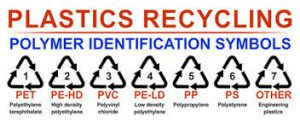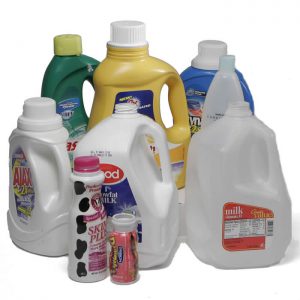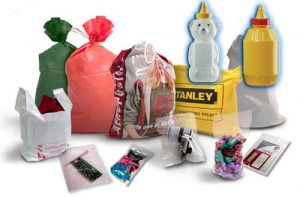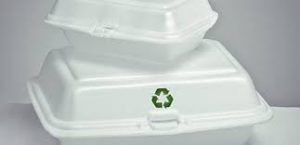 Just because a plastic bottle or container has a “chasing arrow symbol” with a number in it doesn’t mean the item is recyclable. It does mean that we can tell a lot about what kind of plastic it is and how it impacts people and the environment. How the specific plastic will be handled in our recycling system is decided locally.
Just because a plastic bottle or container has a “chasing arrow symbol” with a number in it doesn’t mean the item is recyclable. It does mean that we can tell a lot about what kind of plastic it is and how it impacts people and the environment. How the specific plastic will be handled in our recycling system is decided locally.
What’s in a number?
The numbers on the bottom of plastic containers were not created for consumers to tell them whether something is recyclable. Instead, these Resin Identification Codes or RICS were created for plastic manufacturers and recycling facilities to know what kind of plastic or resin was in a product.
Some plastics can never break down or be recycled. Plastics come in all shapes, sizes and colors. Some can be recycled but only if your curbside recycling program accepts that kind of plastic. For example, #1 and #2 plastics are commonly recycled, but #3 and #5 are rarely recycled in the United States. Here’s what these numbers stand for:
 #1 Polyethylene Terephthalate (PET or PETE)
#1 Polyethylene Terephthalate (PET or PETE)
PET is probably the most used plastic in consumer products. It’s the clear plastic used in soda and water bottles. PET is lightweight, strong, flexible and 100% recyclable. It is recycled back into PET bottles or spun into polyester fiber to make fleece jackets, carpets, sleeping bags and more. PET can be recycled in almost all curbside recycling programs.
 #2 High Density Polyethlyene (HDPE)
#2 High Density Polyethlyene (HDPE)
HDPE is the stronger plastic used in detergent bottles, milk jugs, yogurt tubs and cereal box liners. Because HDPE is so strong and weather-resistant, it is used to make picnic tables, plastic lumber, plastic chairs and, recycling bins. HDPE is commonly recycled in almost all curbside programs.
 #3 Polyvinyl Chloride (PVC)
#3 Polyvinyl Chloride (PVC)
As plastics go, PVC is one of the worst. It is known as vinyl and is soft and flexible when used to make plastic food wrap, teething rings, garden hoses and credit cards. It can also be rigid and used for pipes and furniture. Some think PVC should be replaced with PET whenever possible. Almost all PVC products require virgin raw material. PVC products can be repurposed but are rarely recycled in curbside programs in the United States. Europe recycles PVC.
 #4 Low Density Polyethylene (LDPE)
#4 Low Density Polyethylene (LDPE)
LDPE is responsible for the dreaded plastic grocery bag and six pack rings. It is also in dry cleaner plastics, squeezable bottles and the plastic bags for bread. LDPE items are not typically recycled in curbside programs. Plastic grocery bags can now be recycled at many stores.
 #5 Polypropylene (PP)
#5 Polypropylene (PP)
PP is used in many products like microwaveable containers and lids, straws, ice cream tubs, bottle caps, packaging tape, prescription bottles and lunch boxes. PP was not widely recycled but that is slowly changing and is now recycled in a few curbside programs. Prescription bottles still can’t be recycled which may also have to do with their size jamming the sorting machines.
#6 Polystyrene (PS)
PS or Styrofoam is inexpensive and lightweight and is most commonly used in products like take-out food containers, plastic cutlery, some egg cartons, packing peanuts and meat and vegetable containers. PS is rarely recycled because it’s so difficult. Products made from PS take up a large percentage of our landfills.
 #7 Other (Polycarbonate PC, BPA and PLA)
#7 Other (Polycarbonate PC, BPA and PLA)
This category is a catch-all for PC and other plastics like acrylic and nylon. PC containers made with Bisphenol A (BPA) should be avoided because it is a known endocrine disruptor. BPA is used in baby bottles, sip cups, water cooler bottles and food can liners.
To make matters more confusing, a new compostable plastic made from corn starch is being made to replace PC and comes under the same #7 category. Look for PLA next to the number. PLA cannot b3 recycled. PLA plastics should go in the compost bin.
Find out which numbers are recycled in your area
Knowing the number of an item doesn’t tell you whether it can be recycled. That varies town by town, city by city. You will have to check locally to know whether you can recycle different kinds of plastics in your neighborhood. A national system where everyone can recycle the same plastics in the same way might make things easier.
What do you think? How can recycling be made easier? Please share your ideas in the comments below…